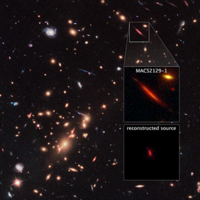Hubble Captures Massive Dead Disk Galaxy that Challenges Theories of Galaxy Evolution
2017-06-21By combining the power of a "natural lens" in space with the capability of NASA's Hubble Space Telescope, astronomers made a surprising discovery—the first example of a compact yet massive, fast-spinning, disk-shaped galaxy that stopped making stars only a few billion years after the big bang.

Finding such a galaxy early in the history of the universe challenges the current understanding of how massive galaxies form and evolve, say researchers.
When Hubble photographed the galaxy, astronomers expected to see a chaotic ball of stars formed through galaxies merging together. Instead, they saw evidence that the stars were born in a pancake-shaped disk.
This is the first direct observational evidence that at least some of the earliest so-called "dead" galaxies — where star formation stopped — somehow evolve from a Milky Way-shaped disk into the giant elliptical galaxies we see today.
This is a surprise because elliptical galaxies contain older stars, while spiral galaxies typically contain younger blue stars. At least some of these early "dead" disk galaxies must have gone through major makeovers. They not only changed their structure, but also the motions of their stars to make a shape of an elliptical galaxy.
"This new insight may force us to rethink the whole cosmological context of how galaxies burn out early on and evolve into local elliptical-shaped galaxies," said study leader Sune Toft of the Dark Cosmology Center at the Niels Bohr Institute, University of Copenhagen, Denmark.
"Perhaps we have been blind to the fact that early "dead" galaxies could in fact be disks, simply because we haven't been able to resolve them."

 Search
Search

